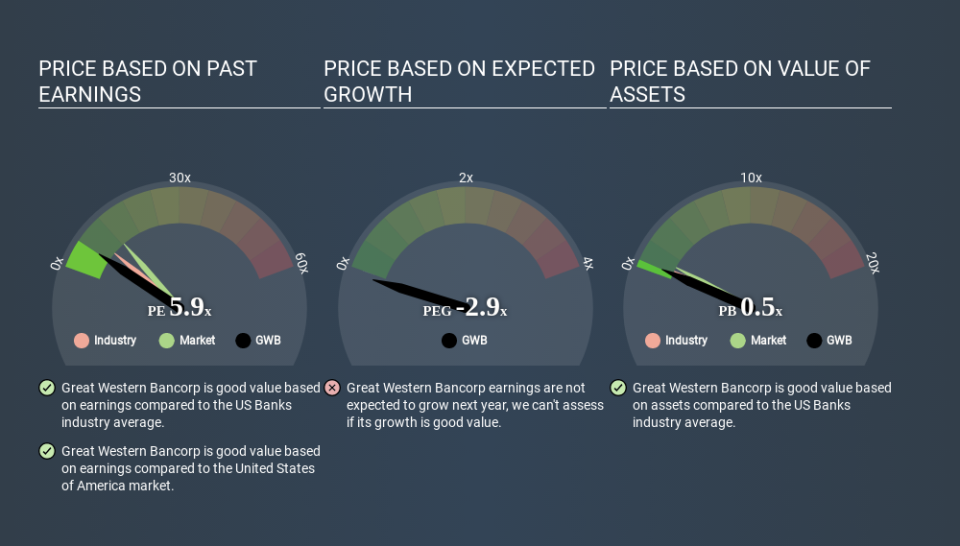A Sliding Share Price Has Us Looking At Great Western Bancorp, Inc.'s (NYSE:GWB) P/E Ratio

Unfortunately for some shareholders, the Great Western Bancorp (NYSE:GWB) share price has dived 33% in the last thirty days. Indeed the recent decline has arguably caused some bitterness for shareholders who have held through the 48% drop over twelve months.
Assuming nothing else has changed, a lower share price makes a stock more attractive to potential buyers. In the long term, share prices tend to follow earnings per share, but in the short term prices bounce around in response to short term factors (which are not always obvious). So, on certain occasions, long term focussed investors try to take advantage of pessimistic expectations to buy shares at a better price. One way to gauge market expectations of a stock is to look at its Price to Earnings Ratio (PE Ratio). Investors have optimistic expectations of companies with higher P/E ratios, compared to companies with lower P/E ratios.
Check out our latest analysis for Great Western Bancorp
Does Great Western Bancorp Have A Relatively High Or Low P/E For Its Industry?
We can tell from its P/E ratio of 5.92 that sentiment around Great Western Bancorp isn't particularly high. The image below shows that Great Western Bancorp has a lower P/E than the average (8.6) P/E for companies in the banks industry.
Great Western Bancorp's P/E tells us that market participants think it will not fare as well as its peers in the same industry. Since the market seems unimpressed with Great Western Bancorp, it's quite possible it could surprise on the upside. It is arguably worth checking if insiders are buying shares, because that might imply they believe the stock is undervalued.
How Growth Rates Impact P/E Ratios
P/E ratios primarily reflect market expectations around earnings growth rates. Earnings growth means that in the future the 'E' will be higher. That means even if the current P/E is high, it will reduce over time if the share price stays flat. And as that P/E ratio drops, the company will look cheap, unless its share price increases.
Great Western Bancorp saw earnings per share decrease by 2.3% last year. But it has grown its earnings per share by 10% per year over the last five years.
Don't Forget: The P/E Does Not Account For Debt or Bank Deposits
The 'Price' in P/E reflects the market capitalization of the company. That means it doesn't take debt or cash into account. The exact same company would hypothetically deserve a higher P/E ratio if it had a strong balance sheet, than if it had a weak one with lots of debt, because a cashed up company can spend on growth.
While growth expenditure doesn't always pay off, the point is that it is a good option to have; but one that the P/E ratio ignores.
Is Debt Impacting Great Western Bancorp's P/E?
Great Western Bancorp's net debt equates to 47% of its market capitalization. You'd want to be aware of this fact, but it doesn't bother us.
The Bottom Line On Great Western Bancorp's P/E Ratio
Great Western Bancorp has a P/E of 5.9. That's below the average in the US market, which is 12.4. Since it only carries a modest debt load, it's likely the low expectations implied by the P/E ratio arise from the lack of recent earnings growth. What can be absolutely certain is that the market has become more pessimistic about Great Western Bancorp over the last month, with the P/E ratio falling from 8.8 back then to 5.9 today. For those who prefer to invest with the flow of momentum, that might be a bad sign, but for deep value investors this stock might justify some research.
Investors have an opportunity when market expectations about a stock are wrong. If it is underestimating a company, investors can make money by buying and holding the shares until the market corrects itself. So this free visual report on analyst forecasts could hold the key to an excellent investment decision.
But note: Great Western Bancorp may not be the best stock to buy. So take a peek at this free list of interesting companies with strong recent earnings growth (and a P/E ratio below 20).
If you spot an error that warrants correction, please contact the editor at editorial-team@simplywallst.com. This article by Simply Wall St is general in nature. It does not constitute a recommendation to buy or sell any stock, and does not take account of your objectives, or your financial situation. Simply Wall St has no position in the stocks mentioned.
We aim to bring you long-term focused research analysis driven by fundamental data. Note that our analysis may not factor in the latest price-sensitive company announcements or qualitative material. Thank you for reading.

